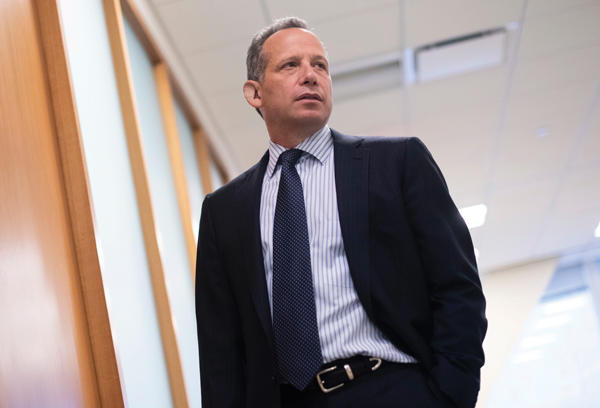Simon Property Group’s $3.6 billion purchase of rival mall owner Taubman Centers in February may seem like just another example of the retail sector’s recent travails. But the takeover actually began four years ago.
Taubman had successfully fended off Simon’s advances since 2002, when it resisted the nation’s largest mall owner’s first hostile takeover bid, thanks to a governance structure designed to keep the REIT firmly in the control of the founding family. Although the Taubmans own less than 3 percent of the firm’s common stock, their Series B shares bring the family’s stake to nearly 30 percent.
But in 2016, Jonathan Litt, the activist investor who heads hedge fund Land & Buildings, started accumulating a stake in the firm and agitating for pro-shareholder reforms. His success — especially ending the firm’s practice of staggered board elections — paved the way for Simon’s long-sought takeover.
“We think it was not a coincidence that Simon was able to acquire Taubman shortly before the first vote where all nine board members will be up for re-election,” said Vince Tibone, a senior analyst at advisory firm Green Street Advisors.
But ironically, in light of the coronavirus crisis afflicting retail, some of Simon’s own shareholders are now questioning the deal. And at the end of March, the country’s largest mall owner, which shuttered its mall of March 18, announced plans to furlough a third of its employees.
REITs can be ripe fruit for activists — particularly those in the struggling retail and hotel sectors — but they can also be tough nuts to crack, due to governance structures and legal protections that insulate their boards from shareholders.
At the same time, activist investors are getting better at surmounting these obstacles and are making many REITs’ notoriously dysfunctional governance better in the process, experts say.
There were 10 activist campaigns against U.S. REITs in 2019, according to data provided to The Real Deal by research firm Activist Insight. And while that was the fewest in five years, they were by far the most successful, netting a total of 13 board seats — the most over the same period.
Of course, top-tier REITs like Vornado and SL Green are far better positioned to fend off such attacks. But further down the food chain, smaller firms can make attractive targets for activist investors — at least those able to overcome their formidable defenses.
 Exploiting dual-class shares, special carve-outs in federal law and quirks of state jurisdiction, the boards of many underperforming REITs have long managed to insulate themselves from shareholder interests, according to Andrew Freedman, a partner at law firm Olshan Frome Wolosky, which has worked with Land & Buildings.
Exploiting dual-class shares, special carve-outs in federal law and quirks of state jurisdiction, the boards of many underperforming REITs have long managed to insulate themselves from shareholder interests, according to Andrew Freedman, a partner at law firm Olshan Frome Wolosky, which has worked with Land & Buildings.
“REITs are a nasty bunch,” Freedman said. “REITs are everything that’s wrong with corporate governance.”
Beta firms
The elite REITs boasting large market caps and solid returns are virtually invulnerable to activist attacks, but large swaths of the sector had already become increasingly attractive targets as market pressures squeezed smaller firms even before the virus outbreak wrought havoc across the retail and hotel sectors.
Nearly 70 percent of activist campaigns over the past six years have targeted REITs in the small- and mid-cap range (with values of $250 million to $2 billion and $2 billion to $10 billion, respectively), according to Activist Insight.
And the retail slump has only heightened tensions between these trusts and their shareholders. Retail REITs posted the lowest returns for the sector in 2019, at 10.7 percent — against an industry average of 28.7 percent — according to data from the National Association of Real Estate Investment Trusts.
Many REITs declined to comment on their interactions with activist shareholders, but experts agree that such investors scent blood in the water.
“If you have a team that’s constantly underperforming, investors are going to push harder,” said Alexander Goldfarb, a senior research analyst at investment bank Piper Sandler.
The worst-performing REIT stock over the 12 months to Feb. 20 was shopping center owner CBL Properties, with returns of negative 73.2 percent. The firm’s weak numbers drew attention from activist investor Michael Ashner, whose Exeter Capital reached a settlement in November for two seats on CBL’s board.
Ashner declined to provide details of his plans, but he told TRD that he’s pushing the board to strengthen the company’s balance sheet and that selling the company outright was not his goal.
“I’ve never really pushed for the sale of a company,” he said. “It’s not a singular objective of mine.”
The next two worst performers have also been targeted for activism or takeovers, albeit unsuccessfully. Hotel operator Ashford Hospitality Trust, with returns of -48.6 percent, won a proxy fight against Rambleside Holdings in 2016. And mall owner Macerich, with returns of -40.4 percent, resisted a takeover bid from Simon in 2015.

Nine of the 10 worst-performing REITs over the 12 months to Feb. 20 were in the retail or hotel sectors — including Pennsylvania Real Estate Investment Trust (-37.7 percent), Corepoint Lodging (-27 percent), Braemar Hotels and Resorts (-25.6 percent) and Pebblebrook Hotel Trust (-22.4 percent), all of which have been targeted by activists.
And this was even before the coronavirus crisis became an existential threat to many hospitality companies and retailers, leaving REITS in those sectors on life support.
None of the 20 worst-performing firms contacted for this story would comment.
Tom Catherwood, a REIT analyst at securities brokerage BTIG, said he expects other companies in these vulnerable sectors to attract more activist attention.
“It wouldn’t surprise me at all to see more activism in retail just because of how the sector has been performing,” he said. “Hotels can potentially be another area where we see more activism, but retail is definitely on top of the list.”
Season of the wolf
Last May, activist investor Bow Street launched a proxy fight aimed at wresting control of Mack-Cali Realty Corporation from its long-entrenched board. The move came days after the firm’s leadership rejected a proposal from Bow Street to spin off its suburban office portfolio into a separate entity.
After settlement talks broke down, Bow Street appealed directly to fellow shareholders at Mack-Cali’s annual meeting last June, successfully installing four independent directors on the firm’s 11-seat board and ousting some of its longest-serving members. Other governance concessions the activist shareholders managed to extract included rescinding the “Mack Agreement,” which allowed the Mack family to nominate up to three members of the board, and the formation of a “Shareholder Value Committee” composed of Bow Street’s nominees.
In December 2019, the board announced its decision to sell off its entire suburban office portfolio on the recommendation of the Shareholder Value Committee.
“The playbook is you make some kind of announcement … hoping that’s going to create buzz,” said Yoel Kranz, a partner at law firm Goodwin Procter, who specializes in defending REITs in activist campaigns. “Then you’re going to try and get that company to call you, and then you try to engage them in a dialogue.”
Activist funds, which tend to own small stakes of 1 to 3 percent in the companies they target, are very collaborative early in their campaigns, teaming up with other dissident investors to form so-called “wolf packs.” These loose alliances of investors pool their shares and influence, aiming to make as much noise as possible to pressure companies in a certain direction.
 Wolf packs are partial to a specific type of prey — stragglers trading at a steep discount to the value of their assets. At the other end of the spectrum, companies that deliver consistent profits to shareholders are mostly seen as invulnerable to dissent, according to Kranz.
Wolf packs are partial to a specific type of prey — stragglers trading at a steep discount to the value of their assets. At the other end of the spectrum, companies that deliver consistent profits to shareholders are mostly seen as invulnerable to dissent, according to Kranz.
“Think of Boston Properties,” Kranz said. The REIT founded by Mort Zuckerman and Edward Linde in 1970 “has had a pretty entrenched board for a while,” he said, “but you’re not going to find an activist in Boston Properties because they return value to investors.”
Boston Properties declined to comment.
Kranz said that his advice to clients varies based on the history of the investors involved. Established players like Litt are often given the benefit of the doubt.
“When we receive overtures from these kinds of strategic or thoughtful activists, my advice to my clients is always to engage,” Kranz said. “Find out what it is that they have to say. It’s not uncommon that they see things about your company that you don’t see yourself.”
The response is more combative when a campaign comes from outside an anointed circle of investors. According to Kranz, he keeps his guard up when he encounters activists with no experience in real estate.
“They’re not real estate players. They just have activist funds. These activist funds have money that they have to spend being active somewhere,” he said.
“Your cred is very important,” Kranz said. “Unless the Street believes that activist has the wherewithal to go to the mat — in other words, to make a proxy statement and get board seats — they’re not going to get a lot of credibility.”
Activist campaigns do require a hefty investment. Exeter Capital’s Ashner, who also heads Boston-based Winthrop Capital Advisors, estimated that costs can run anywhere between $500,000 to $20 million, depending on the size of the target firm. Even then, due diligence may unearth an immovable blockade.
“You look at the likelihood that you can press forward,” Ashner said, “because if somebody owns 40 percent, you might as well drop the pursuit of the company.”
Such was not the case with New York REIT, an offshoot of scandal-plagued American Realty Capital, headed by disgraced executive Nicholas Schorsch.
“Schorsch, who controlled it, had a marginal ownership in the company,” Ashner said. “So it was a situation where we strongly questioned the management of the company.”
When Ashner partnered with developer Steve Witkoff to target New York REIT in 2016, the firm owned prime assets such as 1440 Broadway just south of Times Square, 123 William Street in Lower Manhattan and Twitter’s headquarters at 245-249 West 17th Street in Chelsea.
“The assets appeared to be undervalued,” Ashner said.
Ashner and Witkoff successfully pushed New York REIT to liquidate its $2.8 billion portfolio in early 2017.
Flush with this victory, Ashner initiated a campaign against American Realty Capital New York City REIT, another company tied to Schorsch. As part of Cove Partners III LLC, Ashner owned just 100 shares of the firm, yet he successfully united shareholders to vote down a slate of “shareholder-unfriendly” proposals from the board, including a provision to limit investors’ access to the company’s books.
But after the vote, the trust’s embattled board moved swiftly to defend itself, unilaterally deciding to stagger its board elections to make it impossible for shareholders to replace a majority of its members in a single year.
ARC New York City REIT was able to take this extraordinary measure because, despite its name, the firm was incorporated in Maryland, which Freedman described as “the most shareholder-unfriendly state in America.”
Hard targets
In fact, nearly 80 percent of the 152 companies in the MSCI US REIT Index are incorporated in Maryland, according to a 2019 report from law firm Goodwin Procter.
That is because Maryland law allows them to impose an array of anti-shareholder provisions — often unilaterally — that would be anathema to most publicly traded companies, Freedman said.
For example, the Maryland Unsolicited Takeover Act allows companies to unilaterally “classify” its board, so that only one “class” of board members will be up for re-election each year. According to the Goodwin report, 17 percent of REITs in the index have classified boards.
Mall owner Macerich used the tactic to ward off Simon’s $14 billion takeover bid in 2015, simultaneously rejecting the offer, classifying its board and adopting a poison pill provision that allowed stockholders to buy shares at half price when any investor buys at least 10 percent of the company.
Classified boards are just one of the obstacles activist investors face when dealing with REITs.
“There are just a lot of structures in place to make it very challenging and not necessarily worthwhile for activists to get involved,” Catherwood said.
For example, the IRS’s “5/50” ownership rule prohibits five or fewer shareholders from owning 50 percent or more of a REIT. Some firms even employ an “excess share” provision, under which it can suspend voting rights once a shareholder reaches a threshold, usually 9.9 percent.
These rules used to be enough to keep activists at bay. However, over the past several years, dissident investors have grown more bold, and Catherwood points to one event as the catalyst: the 2013 purchase of BRE Properties by Essex Property Trust.
Litt took an activist stance in BRE in 2012, calling for the sale of the San Francisco-based residential REIT and specifically urging a marriage with Essex. The two multifamily REITs engaged in on-again, off-again merger talks early in 2013, but BRE resisted, prompting Litt to submit an unsuccessful $4 billion bid for the company.
When news broke later that year that Essex made a $4.3 billion offer, Litt called for the sale of BRE, which was agreed to that December.
“It’s very likely that a lot of that agitation led to the merger of those two companies. Following that, we started to see a handful more activist events,” Catherwood said.
Activism Outlook
There is evidence that the increased activism has begun to make REIT boards more accountable, according to the Goodwin report.
“In recent years, a large number of REITs have adopted an array of important governance enhancements — in part by doing what is asked of them by shareholders but also by embracing the business case for improved governance — and we expect that this practice will continue in the years to come,” the report read.
The study, which included all 152 REITs in the MSCI US REIT Index, showed that investors now have more concrete ways to influence the decisions of many company boards.
For example, 32 percent of firms now allow proxy access, up from 19 percent during Goodwin’s previous survey in 2017. And 69 percent of REITs now give shareholders the right to amend bylaws, up from 47 percent in 2017 — though many restrict that right to those who have held 1 percent of the company’s shares for at least five years.
By other measures, however, there has been little improvement. The report showed that the percent of REITs that have classified boards has remained unchanged since 2017. And 5 percent still have a dual-class voting structure — giving pre-IPO shareholders more voting power than investors from the general public — also the same as in 2017.
Progress may be slow, but the work of activist investors will go on, according to Ashner.
“It will happen with some level of frequency,” Ashner said. “REITs are unique, they have a strong defense. But I think it will continue. There’s a place for it.”
Correction, April 8, 2020: This article has been revised to reflect that the Taubman family’s Series B shares bring the family’s ownership stake in Taubman Centers to nearly 30 percent.
